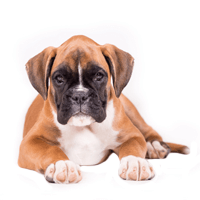
Average Size of Female: Height: 21 – 23.5 inches, Weight: 50 – 65 pounds
Note: Sensitive to heat and anesthesia; white boxers may be deaf.
Suggested tests: Cardiac, hip
Major concerns: Cardiomyopathy, SAS, CHD
Occasionally seen: None
Life Span: 12 – 14 years
Minor concerns: Gastric torsion, tumors, intervertebral disc degeneration, corneal erosion, colitis
Average Size of Male: Height: 22.5 – 25 inches, Weight: 65 – 80 pounds
Brief History on Boxer Origin
Sources claim that the boxer originally was derived from two breeds of dog found in central Europe that no longer exist, The Danziger bullenbaiser and the Brabenter bullenbaiser. It is believed that German hunters tried to create a new breed by crossing the bullenbaisers with mastiff-type breeds and also bulldogs. This resulted in an agile and powerful dog that featured a toned body. This origin states that by 1895, the new breed called the Boxer, had been established. In addition to being related to the Bulldog, it is said that the Boxer was also influenced by a strain of Terrier. One of the first dogs to be used in military and police work, the Boxer became better known as a companion and show dog by the 1900s. The boxer was first registered with the AKC in 1904, and It was about 1940 before Americans showed interest in this breed. The reason being was when the boxer won in Group and Best in Show.
Boxer Breed Appearance
Quite boxy or square in shape and consisting of lean muscle, the Boxer features sloped shoulders and straight, firmly-muscled front legs. The back legs are very firm and toned and have broad, curved thighs. The compact feet feature well-arched toes. The head of this breed does not have many wrinkles. Wrinkles are usually found on the forehead, or in between the eyes above their muzzle. The eyes come in a variety of browns to black, and they offer an intelligent and questioning expression. The ears are usually left natural, and they are thin, lay flat, and are moderate in size. The muzzle features a broad, black nose sometimes with the addition of white areas, and they typically all have an under bite. Muscular and smooth, the neck of this breed is arched and blends nicely into the body. Sometimes docked, but also sometimes left long & natural, the tail is set high when excited or alert. The gait of the boxer is described as strong and energetic. The coat of the boxer is very short and shiny in all areas of the body. The coat can be found in fawn and brindle. The fawns range from light tan or camel shade to mahogany, and the brindle pattern vary from light brown, dark brown to black on a fawn background.
Boxer Breed Temperament
Playful and spirited, the boxer is an attentive, cheerful companion for the family. It is a faithful and gregarious dog that’s normally very patient and gentle with children. While it may have a tendency of being stubborn at times, this breed is sensitive and very responsive to training. It has been known to be aggressive towards unfamiliar dogs, but normally the Boxer is very good with family dogs and pets it has been raised around. This breed bonds closely with its family and requires interaction and love. The playful spirit of this breed is often seen when it paws at food or water dishes when they are empty or acting goofy when it plays around. Boxers need a lot of human companionship as much as they require exercise, and an active & involved family is best. Consistent and firm training from a young age is highly recommended to avoid behavioral issues down the line.
Boxer Breed Maintenance
The Boxer’s smooth, short coat should be occasionally brushed with a firm bristle brush. Bathing should only be done when necessary, because it strips the skin of natural oils like other breeds. The Boxer is considered to be an average shedder. Most will groom themselves as cats do, they are a very clean breed of dog. Both physical and mental stimulation is important for the Boxer breed daily. It’s exercise requirements can be met with a long walk on leash or a trip to the park. Note that this breed does not do well in hot or cold weather so be sure that your living conditions are adjusted accordingly, and be sure not to take them out on walks if it is too hot or too cold out. If provided with enough exercise, the boxer will do perfectly fine in an apartment dwelling. An average-sized yard would be ideal for this breed. This dog is very social, and should be given plenty of time with it’s family.
 Toledo, United States.
Toledo, United States.